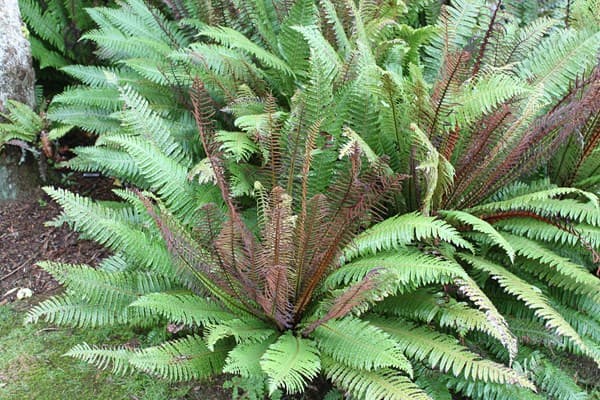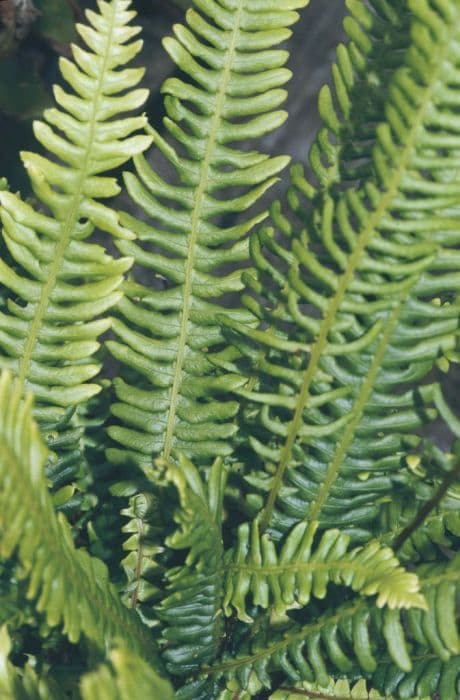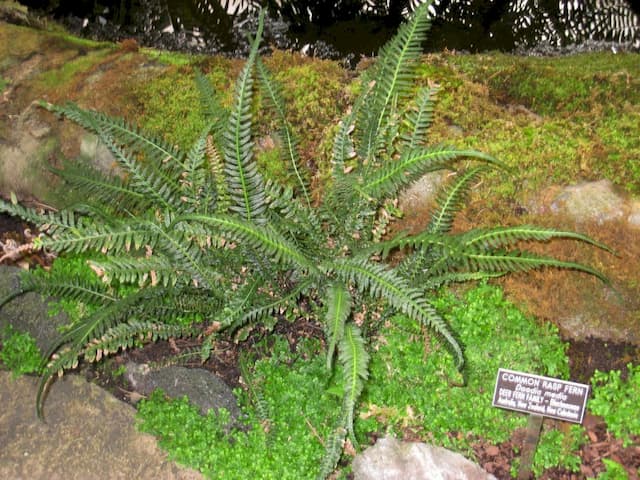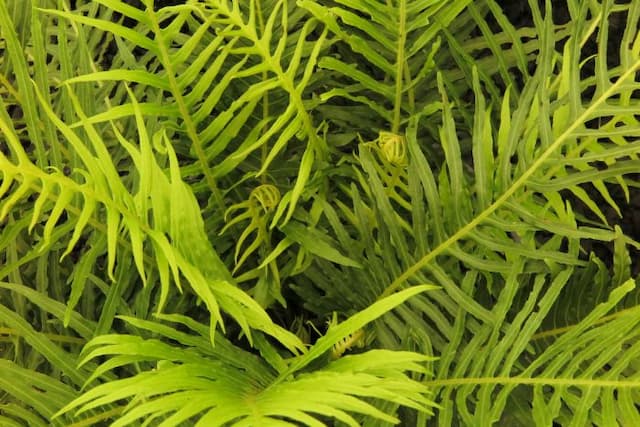Crown fern Blechnum discolor

ABOUT
The crown fern, as it is commonly known, has a tidy and robust appearance, characterized by its lush green, upright fronds that showcase a classic fern silhouette. The fronds emerge from a central base, radiating outwards in a symmetrical pattern, providing the plant with a full and verdant look. The leaves themselves are long and slender, with a slightly wavy or ruffled edge that adds texture and interest. The upper surface of the leaf is a rich, deep green color, with a glossy sheen that catches the light and adds to the plant's vitality. As the fronds mature, they can display a variety of hues, sometimes with a slight bluish or grayish tint, while the undersides are furnished with spore-producing structures that take on a different shade, often a lighter green or brownish color that contrasts with the dark upper leaf surface. The central stalk or stem, from which the fronds extend, is sturdy and may feature scales or a rough texture that complements the softer leafy parts. This contrast in texture is part of what gives the crown fern its distinct and appealing aesthetic. Overall, the plant exhibits a natural elegance that makes it a favored choice for gardens, woodlands, and as a subject of admiration for fern enthusiasts.
About this plant
 Names
NamesFamily
Blechnaceae
Synonyms
Crown Fern, Piupiu, Kiokio, Silver Lady Fern
Common names
Lomaria discolor, Blechnum vulcanicum, Struthiopteris discolor.
 Toxicity
ToxicityTo humans
Blechnum discolor, commonly known as crown fern, does not have prominent records of toxicity to humans. It is not generally considered to be a poisonous plant, and there's limited information available regarding its consumption or contact with the skin. As a precaution, it's advisable to avoid ingesting parts of any wild plant unless it is known to be edible, as they can contain compounds that may be irritating or could cause allergic reactions in some individuals.
To pets
The crown fern (Blechnum discolor) is not specifically listed as toxic to pets. However, like many ferns, it is not typically a plant known for causing serious harm to dogs or cats if ingested. Despite this, some pets may experience mild gastrointestinal upset if they consume parts of the plant. As with any non-food plant, care should be taken to prevent pets from eating crown fern, as individual sensitivity may vary, and eating non-dietary items can sometimes lead to vomiting or diarrhea due to the irritation of the stomach or intestines.
 Characteristics
CharacteristicsLife cycle
Perennials
Foliage type
Evergreen
Color of leaves
Green
Height
3 feet 3 inches (1 meter)
Spread
3 feet (0.91 meter)
Plant type
Fern
Hardiness zones
9a
Native area
New Zealand
Benefits
 General Benefits
General Benefits- Ecosystem support: Blechnum discolor, commonly known as crown fern, provides habitat and food for a variety of wildlife, maintaining ecosystem balance.
- Soil stability: The crown fern's root systems help stabilize soil, reducing erosion in the environments where it grows.
- Aesthetic value: With its lush green fronds, the crown fern adds natural beauty to gardens and landscapes where it's planted.
- Shade tolerance: Crown fern thrives in shaded areas, making it ideal for understory plantings in forested areas or shaded gardens.
- Drought resistance: Once established, it can tolerate periods of drought, which makes it a relatively low-maintenance choice for suitable climates.
- Cultural significance: In some cultures, crown ferns are used for various traditional purposes, like handcrafts or as a natural resource.
 Medical Properties
Medical PropertiesThis plant is not used for medical purposes.
 Air-purifying Qualities
Air-purifying QualitiesThis plant is not specifically known for air purifying qualities.
 Other Uses
Other Uses- Crown Fern as Mulch: The Crown Fern can be used as mulch for garden beds, providing moisture retention and suppressing weed growth.
- Traditional Clothing: In some cultures, the tough fibers of the Crown Fern are woven into durable clothing and accessories.
- Food Wrapping: The large fronds can serve as natural wrapping material for food, adding a rustic touch to presentation.
- Fernery Plant: Enthusiasts of ferneries often use Crown Fern for its attractive foliage and ease of cultivation.
- Erosion Control: The dense root system of Crown Fern helps stabilize soil, preventing erosion on slopes and banks.
- Natural Insulation: Dried fronds have been used historically for insulating buildings and structures.
- Garden Path Edging: The low-lying nature and neat growth habit make it a good candidate for edging garden paths.
- Habitat Creation: Planting Crown Fern in gardens can provide habitat and shelter for small insects and animals.
- Floral Arrangements: Fresh or dried fronds can be used in floral arrangements for texture and greenery.
- Thatching Material: In some traditional practices, Crown Fern fronds are used as a thatching material for roofing.
Interesting Facts
 Feng Shui
Feng ShuiThe Crown fern is not used in Feng Shui practice.
 Zodiac Sign Compitability
Zodiac Sign CompitabilityThe Crown fern is not used in astrology practice.
 Plant Symbolism
Plant Symbolism- Resilience: The hardy nature of the Blechnum discolor, commonly known as Crown Fern, reflects resilience as it thrives in challenging environments.
- Endurance: The Crown Fern's capability to persist through different seasons and weather conditions symbolizes endurance.
- Natural Beauty: Known for its lush greenery and delicate fronds, the Crown Fern symbolizes natural beauty and the elegance of the forest floor.
- Growth and Renewal: As ferns often represent new growth and rejuvenation, the Crown Fern is also associated with the concept of starting anew and the continual cycle of life.
 Water
WaterThe Crown fern needs to be watered when the top inch of its soil feels dry. Generally, this might translate to watering every one to two weeks, depending on the humidity and temperature of the environment. Utilize tepid water and pour gently around the base of the plant, avoiding wetting the foliage, until water starts to drain from the bottom of the pot. For a potted plant, typically 16 to 32 ounces of water during each session should be sufficient. Reduce watering in the winter months when plant growth naturally slows down.
 Light
LightThe Crown fern thrives best in bright, indirect light. It should be placed in a spot where it's shielded from direct sunlight, which can scorch its leaves. An ideal location is near a window with diffused light or a room with plenty of ambient light. Avoid deep shade as this can stunt the plant's growth.
 Temperature
TemperatureCrown ferns prefer a temperature range between 60 and 75 degrees Fahrenheit. They can withstand a minimum temperature of 50 degrees Fahrenheit but freezing conditions can cause serious damage to the plant. To maintain healthy growth, keep your fern in an environment with stable temperatures and avoid sudden drafts or extreme temperature changes.
 Pruning
PruningPruning the Crown fern is mostly done to remove any brown or damaged fronds and to maintain a tidy appearance. It is best to prune in the spring, which allows the plant to focus its energy on new growth. Cut the undesired fronds at the base without harming the central crown. Pruning can be carried out as needed throughout the year to remove old foliage.
 Cleaning
CleaningAs needed
 Soil
SoilCrown fern prefers well-draining, fertile soil rich in organic matter, with a slightly acidic to neutral pH of about 5.5 to 7. A mix of loam, peat, and coarse sand or perlite can work well.
 Repotting
RepottingCrown fern should be repotted every 2 to 3 years, as they grow relatively slowly and need time to establish in their pots without being disturbed too often.
 Humidity & Misting
Humidity & MistingCrown fern thrives best in high humidity conditions, typically between 60% to 80%, to mimic their natural rainforest habitat.
 Suitable locations
Suitable locationsIndoor
Place crown fern in bright, indirect light indoors with high humidity.
Outdoor
In shade or semi-shade; ensure soil is moist, not waterlogged.
Hardiness zone
9-11 USDA
 Life cycle
Life cycleBlechnum discolor, commonly known as crown fern, begins its life as a spore released from mature fern fronds. The spores germinate to form a small, heart-shaped gametophyte (prothallus) that contains both male and female reproductive organs. In a suitable moist environment, fertilization occurs, leading to the development of a zygote which grows into a new sporophyte—the recognizable fern plant. The sporophyte develops roots, a rhizome, and fronds, emerging as a small fern that gradually matures. As the crown fern grows, it produces a rosette of upright sterile fronds for photosynthesis and, with maturity, produces fertile fronds that develop spore cases (sori) on their undersides. These spores are then dispersed, often by wind, to perpetuate the cycle.
 Propogation
PropogationPropogation time
Spring to Summer
Propogation: Crown fern (Blechnum discolor) is propagated primarily through the division of rhizomes, a technique best performed in late winter or early spring before new growth begins. To propagate through division, carefully dig up a mature plant and gently separate the rhizomes into sections, ensuring each section has at least one growth point or frond. These divisions can then be replanted in moist, well-draining soil, ideally in a shaded or semi-shaded location to mimic the fern's natural understory habitat. The divisions should be planted at the same depth they were originally growing and watered thoroughly. New growth typically appears within a few weeks, and the divisions will gradually establish themselves as independent plants.




